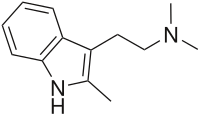From Wikipedia, the free encyclopedia
Chemical compound
2,N,N -trimethyltryptamine , 2,N,N -TMT , or 2-Me-DMT is a
tryptamine
derivative that is a
psychedelic drug. It was invented by
Alexander Shulgin and reported in his book
TiHKAL (#34).
[1] It is claimed to show psychoactive effects at a dosage of 50–100 mg orally, but these are relatively mild compared to other similar drugs, suggesting that while the 2-methyl group has blocked the binding of metabolic enzymes, it is also interfering with binding to the 5HT2A receptor target that mediates the hallucinogenic effects of these drugs.
Legal status Sweden's public health agency suggested classifying 2-Me-DMT as a hazardous substance, on May 15, 2019.
[2]
See also References External links
Psychedelics (
5-HT2A
Benzofurans
Lyserg‐
Phenethyl‐
2C-x
25x -NBx
25x -
NB 25x -
NB3OMe 25x -
NB4OMe 25x -
NBF 25x -
NBMD 25x -
NBOH 25x -
NBOMe Atypical structures
25x -NMx
N-(2C)-fentanyl
3C-x 4C-x
DOx HOT-x
MDxx Mescaline (subst.)
TMAs
TMA
TMA-2
TMA-3
TMA-4
TMA-5
TMA-6 Others
Piperazines
Tryptamines
alpha -alkyltryptamines x -
DALT x -
DET x -
DiPT x -
DMT
4,5-DHP-DMT
2,N,N-TMT
4-AcO-DMT
4-HO-5-MeO-DMT
4,N,N-TMT
4-Propionyloxy-DMT
5,6-diBr-DMT
5-AcO-DMT
5-Bromo-DMT
5-MeO-2,N ,N -TMT
5-MeO-4,N ,N -TMT
5-MeO-α,N,N-TMT
5-MeO-DMT
5-N ,N -TMT
7,N,N-TMT
α,N,N-TMT
(Bufotenin) 5-HO-DMT
DMT
Norbaeocystin
(Psilocin) 4-HO-DMT
(Psilocybin) 4-PO-DMT x -
DPT Ibogaine-related x -
MET x -
MiPT Others
Others
Dissociatives (
NMDAR antagonists )
Deliriants (
mAChR antagonists ) Others
1-Methylpsilocin
2,alpha-DMT
2-Me-DET
2-Methyl-5-HT
2,N,N-TMT
4,5-DHP-DMT
4,5-MDO-DMT
4,5-MDO-DiPT
4-AcO-DALT
4-AcO-DET
4-AcO-DMT
4-AcO-DiPT
4-AcO-EPT
4-AcO-NMT
4-AcO-MALT
4-AcO-MET
4-AcO-DPT
4-AcO-MiPT
4-F-5-MeO-DMT
4-HO-5-MeO-DMT
4-HO-DALT
4-HO-DBT
4-HO-DET
4-HO-DiPT
4-HO-DPT
4-HO-DSBT
4-HO-EPT
4-HO-MALT
4-HO-MET
4-HO-McPT
4-HO-McPeT
4-HO-MiPT
4-HO-MPMI
4-HO-MPT
4-HO-MsBT
4-HO-NMT
4-HO-PiPT
4-HO-pyr-T
4-HO-αMT
4-Me-αET
4-Me-αMT
4-MeO-DiPT
4-MeO-DMT
4-MeO-MiPT
4-PrO-DMT
5,6-MeO-MiPT
5,6-MDO-DiPT
5,6-MDO-DMT
5,6-MDO-MiPT
5,7-Dihydroxytryptamine
5-BT
5-Bromo-DMT
5-CT
5-Chloro-αMT
5-Chloro-DMT
5-Ethoxy-αMT
5-Ethoxy-DMT
5-Ethyl-DMT
5-Fluoro-AET
5-Fluoro-αMT
5-Fluoro-DET
5-Fluoro-DMT
5-Fluoro-EPT
5-Fluoro-MET
5-HO-αMT
5-HO-DiPT
5-HTP
5-iPrO-AMT
5-MeS-DMT
5-Methoxytryptamine
5-MeO-7,N,N-TMT
5-Methyl-αET
5-MeO-2-TMT
5-MeO-αET
5-MeO-αMT
5-MeO-DALT
5-MeO-DBT
5-MeO-DET
5-MeO-DiPT
5-MeO-DMT
5-MeO-DPT
5-MeO-EiPT
5-MeO-EPT
5-MeO-MALT
5-MeO-MET
5-MeO-MiPT
5-MeO-MPMI
5-MeO-NMT
5-MeO-pyr-T
5-MeO-NBpBrT
5-Methyl-DMT
5-(Nonyloxy)tryptamine
6-Fluoro-αMT
6-Fluoro-DMT
6-Hydroxymelatonin
6-MeO-THH
7-Chloro-AMT
7-Methyl-α-ethyltryptamine
7-Methyl-DMT
Acetryptine
Aeruginascin
αET
Alpha,N-DMT
α,N,N-Trimethyltryptamine
Alpha,N,O-TMS
AL-37350A
αMT
Baeocystin
BNC-210
Bufotenidine
Bufotenin (5-HO-DMT)
BW-723C86
Convolutindole A
CP-132,484
DALT
DBT
Desformylflustrabromine
DET
DiPT
DPT
E-6801
E-6837
Ethocybin
EiPT
EMDT
EPT
FGIN-127
FGIN-143
Harmaline
HIOC
Ibogaine
Idalopirdine
Indorenate
Iprocin
Lespedamine
Luzindole
MET
Methylbutyltryptamine
MiPT
MPT
Miprocin
Melatonin
MPMI
MS-245
NAS
N-Ethyltryptamine
N-Feruloylserotonin
NMT
DMT
Norbaeocystin
Normelatonin
N-t-Butyltryptamine
O-4310
Oxypertine
Plakohypaphorine
PiPT
Psilocin (4-HO-DMT)
Psilocybin (4-PO-DMT)
Pyr-T
Rizatriptan
RU-28306
Serotonin
ST-1936
Sumatriptan
Tryptamine
Tryptophan
Yohimbine
Yuremamine
Zolmitriptan
